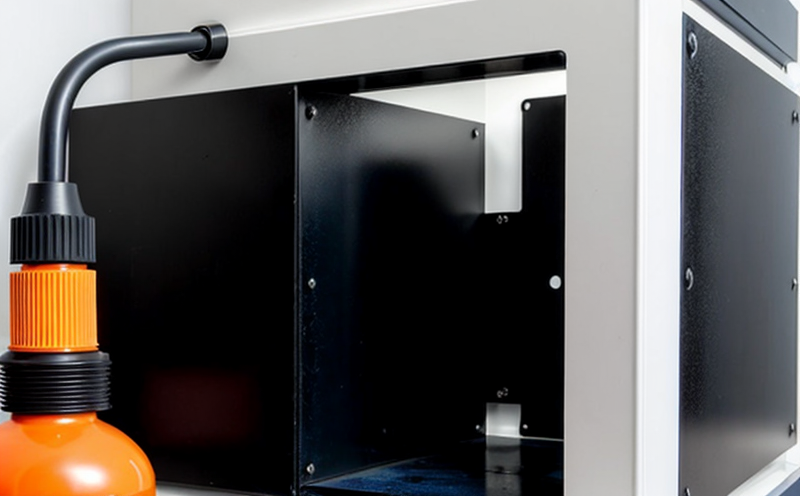DIN EN 13523 6 Impact Resistance of Coil Coated Surfaces
The DIN EN 13523-6 standard is a crucial document in the realm of nanocoatings and surface treatments testing, particularly for coil-coated surfaces. This standard provides a comprehensive framework to assess the impact resistance properties of these materials, which are essential for applications ranging from automotive coatings to industrial protective films.
Coil coating involves the continuous application of coating material over metal substrates using a recoiling process. The primary objective is to ensure uniformity and adherence of the coating across the substrate, creating durable and protective layers. DIN EN 13523-6 addresses the critical issue of how these coatings withstand mechanical impacts without compromising their integrity.
The standard outlines specific procedures for testing the impact resistance of coil-coated surfaces using pendulum impact testers. These tests are designed to simulate real-world conditions where surfaces may encounter significant mechanical stress, such as during transportation or use in harsh environments. The test setup involves a pendulum that strikes the coated surface at controlled angles and velocities.
The standard specifies detailed protocols for specimen preparation, including the type of coating, substrate material, and dimensions. It also defines the parameters for testing, such as impact energy, angle of incidence, and the number of impacts required to induce failure or assess damage.
For accurate results, it is essential to follow these procedures meticulously. The testing apparatus used in compliance with DIN EN 13523-6 must meet stringent quality standards, ensuring consistent and reliable test outcomes. This includes high-precision pendulum impact testers capable of delivering controlled impacts and advanced data recording systems for precise measurement.
The results from these tests are critical for quality managers and R&D engineers as they provide insights into the durability and reliability of nanocoatings in various applications. Compliance officers can use this information to ensure that products meet regulatory requirements, while procurement teams can rely on it to select high-quality suppliers and materials.
Understanding the impact resistance properties is not just about meeting standards; it also involves optimizing product performance. By leveraging DIN EN 13523-6, manufacturers can enhance the durability of their coatings, ensuring they withstand environmental stresses without compromising safety or functionality.
The standard's impact on various sectors cannot be overstated. In automotive manufacturing, for instance, the ability to assess and improve the durability of protective coatings is crucial. Similarly, in industrial applications, where materials must endure harsh conditions, understanding and enhancing impact resistance can significantly extend product life and reduce maintenance costs.
Quality and Reliability Assurance
- Specimen Preparation: The standard mandates precise preparation of the coating samples, ensuring uniformity in thickness and adherence to substrate surfaces. This includes controlled drying times and temperature conditions.
- Testing Equipment Calibration: Regular calibration of impact testers is crucial for maintaining accuracy and reliability in test results. This ensures that each measurement aligns with international standards and provides consistent data across multiple tests.
The quality assurance process involves rigorous testing protocols, ensuring that every batch of coated materials meets the stringent criteria set by DIN EN 13523-6. Compliance with these standards not only enhances product reliability but also builds trust among end-users and stakeholders.
R&D engineers play a pivotal role in refining test procedures to enhance coating performance. By continuously improving methodologies, they contribute to the development of more robust and efficient coatings that meet both current and future regulatory requirements.
The importance of quality assurance extends beyond manufacturing processes. It also involves comprehensive documentation and reporting of test results. This transparency ensures that all stakeholders have access to accurate data, facilitating informed decision-making throughout the product lifecycle.
International Acceptance and Recognition
- Global Adoption: DIN EN 13523-6 is widely recognized across Europe and beyond. Its adoption by numerous industries ensures consistency in testing methodologies, which is crucial for international trade and collaboration.
- Interoperability: The standard's clear specifications allow different laboratories to achieve comparable results, enhancing interoperability between testing facilities worldwide.
The recognition of DIN EN 13523-6 by leading standards bodies adds credibility to the testing process. This global acceptance ensures that manufacturers and suppliers can confidently present their products to international markets, knowing they meet stringent quality benchmarks.
International laboratories accredited in accordance with ISO/IEC 17025 are often preferred for conducting DIN EN 13523-6 tests due to their rigorous calibration procedures and adherence to best practices. This ensures that the results obtained are not only reliable but also internationally recognized, fostering trust among global partners.
The standard's international acceptance is further bolstered by its alignment with other relevant standards such as ASTM E749 and ISO 16578. This harmonization across different regions enhances compatibility and interoperability, making DIN EN 13523-6 a cornerstone in the global nanocoatings industry.
Environmental and Sustainability Contributions
The testing of impact resistance for coil-coated surfaces under DIN EN 13523-6 not only ensures product performance but also contributes positively to environmental sustainability. By improving durability, these coatings reduce the frequency of replacements and maintenance, leading to lower waste generation and resource consumption.
Enhanced longevity translates into reduced energy usage during production processes and extended service life for end-user products. This aligns with broader sustainability goals by promoting efficient use of materials and minimizing environmental impact throughout the product lifecycle.
The standard's focus on precise testing ensures that only high-quality, durable coatings are brought to market. This minimizes the need for rework or disposal of defective products, further supporting sustainable practices in manufacturing.
Furthermore, the harmonization of standards like DIN EN 13523-6 across different regions encourages a collaborative approach to product development and quality assurance. This collaborative effort fosters innovation while promoting responsible environmental stewardship.





